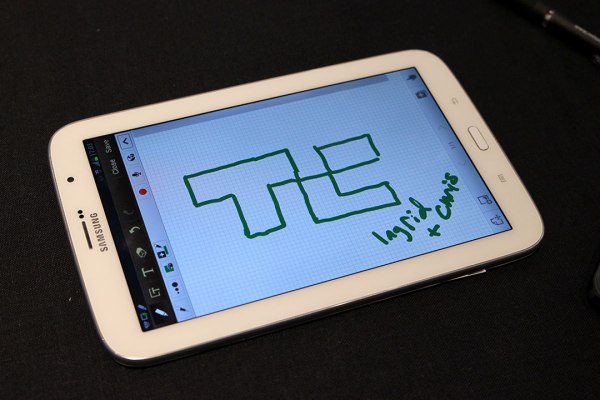That Samsung was tinkering with a slightly smaller Galaxy Note tablet shouldn’t come as a surprise, but consider this the final word if you still weren’t a believer. Samsung has just officially revealed that the Galaxy Note 8.0 is indeed a real product, and that it’s planning on rolling the tab out across the globe starting in Q2 2013.
Though the company didn’t have anything firm to share when it came to release dates or pricing, it did have plenty to talk about in terms of hardware. The Note 8.0 tablet runs a TouchWiz’d version of Android 4.1.2 Jelly Bean, and sports a Exynos 4 Quad processor clocked at 1.6GHz, 2GB of RAM, and (you guessed it!) an 8-inch TFT LCD display running at 1280 x 800. Perhaps it’s not the most surprising spec sheet we’ll see here at MWC, but it’s certainly plenty of horsepower for a tablet this size and it shows (more on that later).
Sadly, there’s no word yet on what the Note 8.0 will cost, though Samsung representatives were quick to peg the device as being “affordable.” Naturally, though, that will all depend on the configuration you’re looking at — Samsung will be selling Wi-Fi and 3G models with either 16 or 32GB of internal flash storage. The company also confirmed that an LTE-friendly version of the Note 8.0 was in the works, and that it would eventually grace the United States thanks to some crucial carrier (yet unspecified) partnerships.
TechCrunch got to take the Note 8.0 for a test drive earlier today, and it’s clear that Samsung has been doing some fine-tuning since the last time it released a Note tablet.
In terms of design though, the Note 8.0 doesn’t really bring anything new to the table. As Darrell pointed out when the first batch of leaked images started making the rounds, it resembles a blown-up Note 2 phablet with its portrait orientation, physical home button and soft-key placement more than it does a Note 10.1 tablet. It’s significantly slimmer than the last pint-sized tablet Samsung pushed onto the market too, which makes holding it with one hand slightly more comfortable even though it has a larger display.
As you might expect, I was able to whip through homescreens, dive in and out of apps, and (most importantly) doodle to my heart’s content with nary a hint of lag. I wasn’t able to run any benchmarks to prove my point conclusively, but the whole package felt snappier and more responsive than the Note 10.1 tablet. Part of that perceived performance boost can probably be attributed to Google’s Project Butter enhancements, but the snappy chipset and the fact that the pre-release software build was largely unfettered by cumbersome widgets and visual cruft didn’t hurt either.
Cameras built into tablets very rarely impress, and that’s exactly the case with the Note 8.0’s 5-megapixel rear camera and 1.3-megapixel front-facer. Colors tended to be a little lifeless and washed out overall, and images snapped with the front-facing camera were grainy and unsatisfying. They’ll certainly do in a pinch if you absolutely have to take a photo, but it’s very likely that your phone’s camera would outshine the Note 8.0 any day.
Speaking of software, the Note 8.0 is loaded up with the now-standard slew of S Pen-friendly apps and features, albeit with some nifty updates. Multi-window multi-tasking (my favorite feature on the Note 10.1) now lets users split screen their phone calls, and the S Note app has been updated with new templates and notably improved handwriting detection and recognition. It’s still not perfect, but the Note 8.0 was generally able to decipher my chicken-scratch with more accuracy than the last Note tablet.
With the Note 8.0, Samsung has finally gotten around to cleaning up one of the Note series’ most annoying quirks. Despite being devices that leaned heavily on the S Pen to differentiate them from their competition, owners of the original Note and Note 2 phablets couldn’t actually use the pen to trigger the capacitive touch buttons. Thankfully, that’s no longer the case — better late than never, I guess.
Like the Note 10.1 before it, the Note 8.0 also sports an IR blaster and a remote control/channel guide application courtesy of long-time partner Peel. It’s no secret that Samsung (like so many others these days) is looking to solidify itself as a force in the living room, and continuing this little trend is yet another way for Samsung to highlight the value of buying into its hardware ecosystem.
And, perhaps most curiously, the 3G-friendly version of the Note 8 allows users to place voice calls. To my utter surprise, it actually worked very well: the Note 8’s microphone was sensitive enough to deliver reasonably crisp, loud audio even in a room full of eager, chatty tablet tinkerers. I can’t imagine many people taking advantage of this little feature (if only because you’ll look more than a little silly if you do), but that won’t be an issue for everyone — Samsung has said that the voice call feature won’t make it to every region where the Note 8.0 will be sold.

